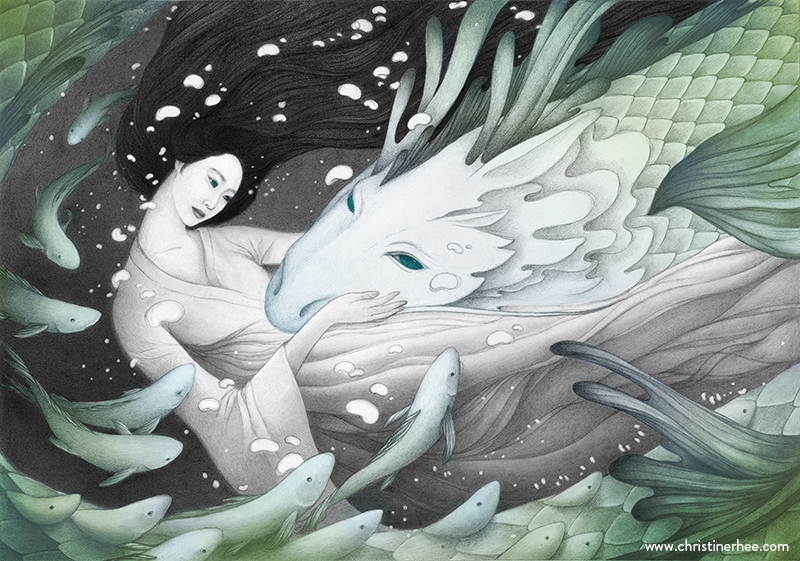An interview with Artist and Illustrator Christine Rhee
Illustrations by Christine Rhee.
Recently, I had the distinct pleasure of interviewing Christine Rhee, a talented artist and illustrator who was really a joy to talk to. Christine has had a bumpy road on her journey to becoming the artist she is today, but she’s persevered and learned to trust herself in the face of obstacles ranging from uncertainty about her life’s path, to disapproving family members, to simple lack of motivation, and has come out a stronger person for it.
Jorie McKibbin (aka Indigo Dusk): Tell us a little about yourself as a person.
Christine Rhee: Hi! I’m an artist and illustrator living in San Francisco. I have two house/studio bunnies. They love to hide in the nooks and crannies as I draw or work on the computer. I try to keep them from “helping” with my artwork too much!
Jorie: What was it about art that attracted your attention? What made you want to make art in the first place?
Christine: Looking back I think I was always interested in art. But growing up in an immigrant family, it went unnoticed. I’d draw on my own and even borrowed books from the library about drawing animals and such. I’d had sporadic public school art classes here and there, mostly craft projects. Most of those avenues dried up around middle school.
Years later, I took my first formal drawing class as an elective in the middle of my pre-med and bio undergrad degree in Molecular Cell Biology. I’d just never felt so complete and connected before! I was in trouble! While I was drawing I felt like I was finally using all of me — my heart and soul vs just my intellect and discipline. As I drew, I found energy to draw more. It was truly an altering experience. After tasting that it was hard to go back.
I’ve wandered back and forth, going for a second bachelor’s in Animation & Illustration, and back to bio, and now back to pursuing fine art and illustration. Ultimately, this feeling of wholeness and complete-ness guides me and I’ve had to learn to recognize when I’m following my more “practical” concerns vs what I truly want to do in life. Life is too short to live a lesser life than one where I can feel fully engaged.
J: What's your earliest significant memory involving art? This can be art you made, or someone else's art that resonated with you somehow.
C: I was obsessed with Chris Van Allsburg’s The Mysteries of Harris Burdick in second grade. My teacher had challenged me to write stories to go with the mysterious lines in the book with their accompanying evocative images. I wrote several of these little short stories for the class. Eventually she gave me the book! It’s still on my shelf today. Much later, my mom happened to take me to a visiting Van Gogh exhibit at the LACMA. I just remember trying to take in all the energy, the colors, and quotes from his letters to his brother Theo. His work just felt so alive. You could feel the objects, even the air flowing around them.
.jpg)
J: In broad strokes, can you tell us about your journey to becoming a professional artist, and what key decisions helped you get there?
C: I finished my degree in Animation/Illustration in 2009 but I didn’t feel like an artist until years later. I felt like someone who had studied to be an artist but wasn’t sure what I actually wanted to do.
I had to commit to being an artist. I had to give myself permission to be an artist. I always felt like I had to “achieve” something greater — accomplishments, financial success, respect — probably as a result of my upbringing and a desire to honor my parents and my loved ones. It took me a really long time to sort through all my different values and desires to realize that if I really committed to it, I could achieve it all with art — to help and connect with others, to encourage others, to inspire and enrich their lives, to help them get along on their paths to being the best version of them.
The financial part I’m still working on… but nothing beats feeling so connected to myself, to other people, to that universal feeling of being a human being than art does for me.
Once I decided I wanted to do art, it was easier. I needed additional instruction to achieve the kind of art I wanted to create. I wanted a community and mentors that would help me have a positive relationship with art-making and guide me through the business aspects. i found much of that through Smarter Art School classes, Illustration Master Class and IlluxCon.
J: Many artists struggle to stay motivated and practice regularly. Have you struggled with this common problem? If so, how have you pushed past it?
C: I struggle with this EVERY DAY. From talking with mentors and other artists who’ve been at this for decades, THEY still struggle with it. I think it’s just part of being an artist. I think the key is to have many avenues leading to creating more art. I’ll share a few I’ve been relying on lately.
Personally, I find it easiest to keep moving when I’m working on project to project, especially when I know what to tackle next. I keep a folder of thumbnails I like but haven’t had a chance to work on. For the ones that still resonate, they often become the next project. I have enough of a system of working on images now (thumbnail, reference gathering, line drawing, refine drawing, values, render, color study, and color) that once I have an idea I’m excited about, I can often get back into working. In fact, I get impatient and cranky when I don’t get to work on it!
I like having a mentor or group of artists to be accountable to and share regularly with. Nothing like a deadline to keep you motivated! I’ve found a community of artists to be really helpful. We exchange ideas for how to get unstuck, give each other permission to try new things, support each other when trying something scary, and reassure each other that being stuck is part of the process sometimes and that we will work through it. It feels great to share your work for feedback or just to share what you’re working on.
Oftentimes, losing motivation is a sign of something being “off.” It could be that I’m not happy anymore with the composition of the piece I’m working on. I might have drifted from the emotional moment in the piece. It could be that I’m not relaxing or getting out of the studio enough and putting too much pressure on myself.
And finally, having a creative routine or triggers for creating really helps. For some people it’s music, audiobooks, or podcasts. For me it’s usually a visually evocative, emotional or psychological TV show in the background. It’s almost like a soundtrack and I end up watching it a few times, so even if I miss some details here and there, I really get to dig in on the emotions, metaphor, and imagery.
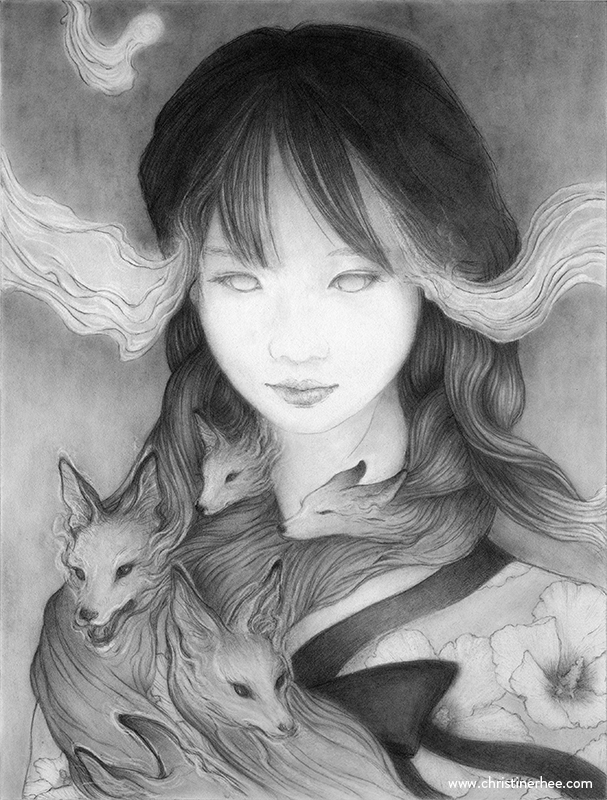
J: What other struggles have you faced as an artist, and how have you overcome them?
C: I was pretty fortunate in that my boyfriend, now husband, has always been supportive of my art pursuits. Though I wandered around a lot in terms of my art journey, those years allowed us to build financial stability so that I could focus on building my art career.
However, my family was almost violently opposed to my being an artist. Looking back, they didn’t really understand that art would be a way for me to realize all my potentials vs pursuing something more understandable like medical school. They even had a family meeting with all my extended relatives to discuss whether I should do art or not (the consensus was no, by the way). Even as of 2017 they were still suggesting that they would pay for my med school tuition if I ever chose to go back. Ultimately, I had to mature, commit, and learn to pursue my own goals. I had to realize they wanted me to be happy and successful as any loving family does. When I finally started making art that was meaningful to me and shared my art with them, they became increasingly supportive.
Though I learned a lot from my art program, they were extremely non-supportive of illustration or gallery art as a career path. Beyond not having the support or coursework to pursue that desire, I just didn’t have the skill level to create a finished image. I also didn’t know how to pursue those careers. Both of those required more instruction, which I found with Smarter Art School and IMC.
J: What role do you think formal education plays in an artist’s development? Do you think it’s necessary to become a great artist?
C: I was starting at almost no instruction in art prior to school so I’m all for it!
Everyone has their own way of learning. I personally really benefit from a structured approach to learning. Since I had academic rigor from pursuing my science degree, it was natural for me to find formal instruction to get the basics again. My BFA was the fastest way to learn a lot of technical and foundational skills in a disciplined way. Even though that particular program didn’t align with my longer term goals perfectly, I still learned so much about drawing, composition, color, picture-making, gesture, etc that I was able to carry over into my later studies.
It’s more a matter of discipline and time. During art school, I was studying art for 40-80 hours a week between class time and assignments. There’s just so much skill to learn to be proficient at art! Self-study is great for those who are that disciplined. If you have the desire and discipline as a novice artist to really do dedicated study, that’s great! There are so many tutorials and workshops available now! For myself, I need structure to get me to where I want to go as quickly and efficiently as possible. Otherwise, it’s too easy for life and its many challenges and demands to get in the way of pursuing my art. :)
I think the big caution with formal instruction is whether you have the freedom to be yourself. If you find mentors and programs that will nurture you to develop your own voice and find what motivates you as an artist on top of fundamental skills… hold on to them for the gold that they are!
J: Do you have any advice for artists to whom formal art education isn’t available? How can such artists learn and grow through self-study and peer support to overcome this obstacle?
C: For those for whom it isn’t an option…there are some great books, tutorials, and workshops out there! Muddycolors.com is a great source on a wide range of topics from masters in the Sci-Fi/Fantasy field. They also have a Patreon with once a month video demos from amazing artists! OneFantasticWeek.com is a weekly videocast that brings in guest speakers such as artists, art directors, etc and they talk about the business of being an independent artist. They also have an active Facebook group, for community building. There are other great organizations like Schoolism and ConceptArt.org that offer great tutorials and community for artists with more digital art and concept art skills.
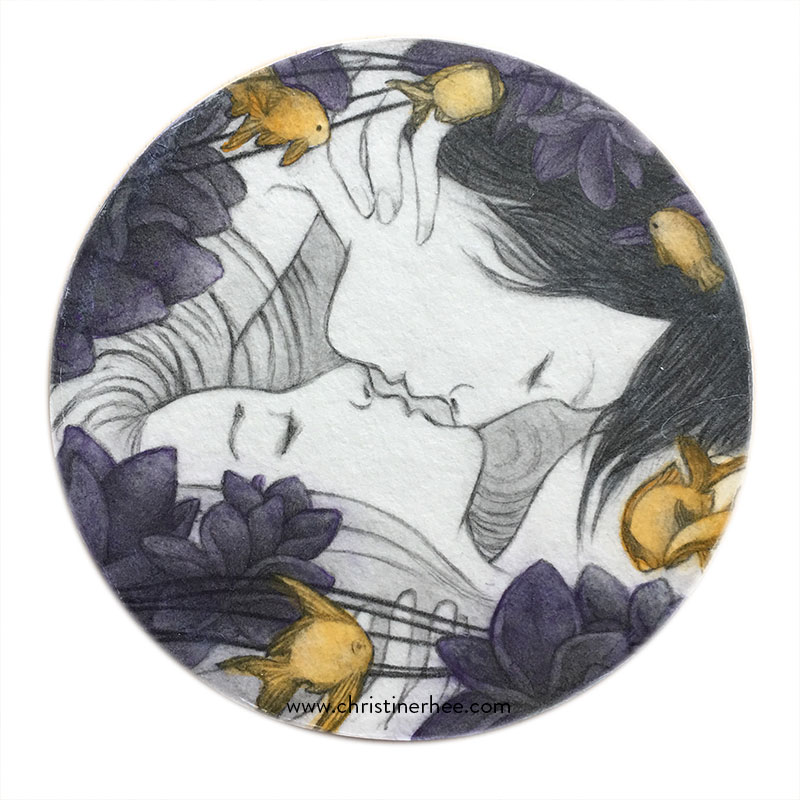
J: Do you have any advice for budding artists in general?
C: It sounds pretty prosaic, but also extremely important… Trust that you’re an artist because you want to create things. Keep drawing or painting or whatever is your medium. The skills will come as long as you’re continuously building towards growing. There is a wealth of great tutorials, books, and mentors out there. Whatever stage you are in, focus on your next steps to get you towards your big dream. The biggest challenge is trying to hone into what that dream is! Read interviews, look at the art that inspires you and see if the life and art that those people are describing is the kind that you want. You can always work your way towards something, but no one can guarantee that that outcome will make you happy other than yourself.
J: What role did mentorship play in your journey to become a successful artist?
C: My work just wouldn’t be where it is right now without mentorships. I had my fundamentals from my BFA, but I just didn’t know how to use reference in a sensitive way or how to take images to a polished finish. Prior to my mentorship, I just didn’t have anything other than the most rudimentary figures in my work. I also didn’t have a community in the fields I was interested in and didn’t really know anything on the business side of the careers I wanted to pursue. The mentorships allowed me to build up those skills, narrow down what my next steps were, and encourage me to apply to things when I needed to.
J: How about peer support? Do you have any artist buddies you bounce ideas back and forth with? If so, how does that help keep you inspired and motivated
C: Peer support is really important too! Right now, I still tend to rely on my mentorships more for feedback vs my peers, but with the peers I’ve gained through these mentorships I know I can get real quality feedback. Also it’s a huge source of information and encouragement. We trade notes on what shows are worth applying for and attending, congratulate each other on our victories and console each other with setbacks.
There are a lot of ups and downs and psych outs with the process of creating art. It’s just not possible to continue to create and fight the good fight without other people alongside you.
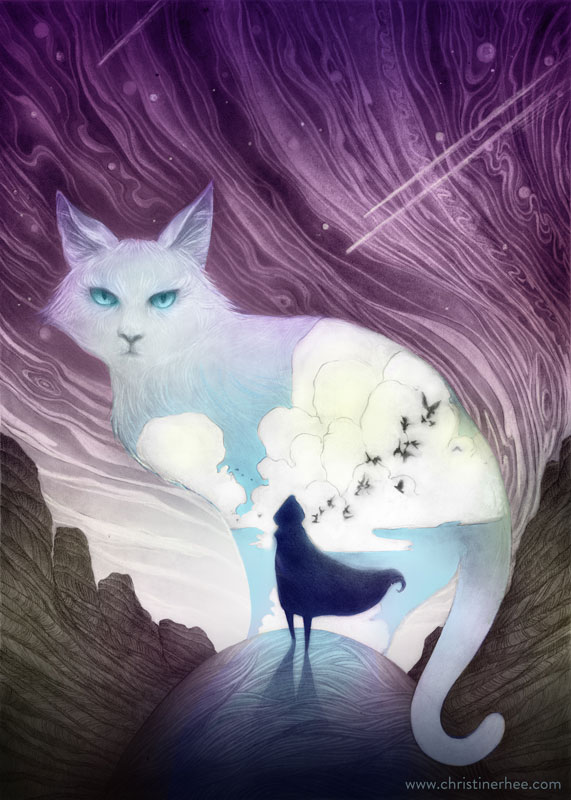
J: While browsing your work, I notice that both water and plant-life seem to be repeating elements in many of your pieces. Is there a reason for that?
C: I think it’s just a natural gravitation. I’m comforted and inspired by nature and how we as humans fit into the universe and our life journey. I find the ocean extremely meditative and grounding. Living and interacting with my pets also grounds me into the present day and my body. Many of the stories and imagery that resonate with me have nature involved in some way because nature inspires and soothes me. I want to remind people that there is a larger world than their feelings and their thoughts.
J: I noticed you have a degree in molecular cell biology and immunology. I can’t help but be curious; how’d you go from studying the sciences to a career as a professional artist?
C: With a lot of denial and opposition internally and externally? Hahaha. I was definitely fully-committed to being a doctor before I found real art instruction! Once I discovered what life was like with art in it, my fate was sealed. I kicked and screamed and tried “safer” paths even within art like graphic design, art direction or trying to prepare my portfolio for animation or game studios. I had this perception that there had to be a single source of income with my work and that only gives you certain options. It ultimately didn’t work out for me. I think my interests and sensibilities are better aligned for freelance and personal projects vs a team based collaborative project and going into an office every day of the week.
On another level, switching from medicine to art wasn’t that big a leap. I wanted to help people as a doctor. But in volunteering at hospitals and studying the materials, I came to the realization that maybe medicine wasn’t the best way for ME to help others. It felt valuable and I was definitely making a difference, but I came home exhausted and drained. In contrast, art gave me more energy! I’d always responded to images, books and stories. Finding a great book cover in a bookstore, seeing art that moves me in a museum…those experiences feed me and helped me find meaning in my life. I wanted to provide that kind of connection and fuel for others. I still wanted to help others, but when I was making art, I was rejuvenated by the process and method I wanted to connect to others, in a way that science and medicine did not do for me.
J: Tell us about these super cute bunnies mentioned on your site!
C: I’ve been adopting bunnies from different rescue organizations since 2003. At our max, we had six! (that wasn’t exactly intentional) We have two boys right now and they’re kind of a handful, so we’ll probably hold off on adding more for a while. They like to find all the nooks and crannies in my studio and they keep me on my toes! Sometimes they try to “help” with my paper and boards. It’s super peaceful when they sit near me and nap or want the occasional pet session. They are especially adorable when they’re eating or begging for treats. :)
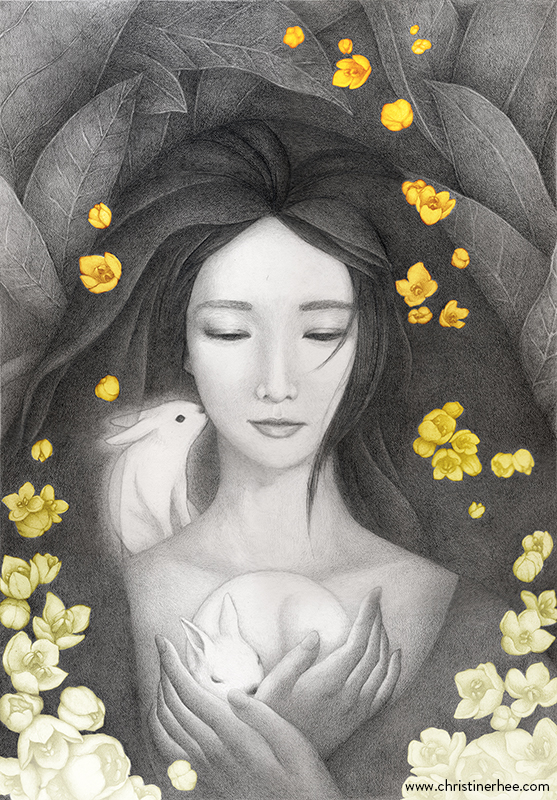
J: What motivated you to submit to the society of illustrators?
C: Now that I have a consistent body of work, I have a list of a few annuals and competitions that I plan on applying to every year. I see them as a way to share my work with the community and people who hire for jobs. For me, whether I get in or not is secondary. Because there is a jury involved, you never really know whether you’ll get a piece in or not. It could have made it or not by a single vote. I’ve also heard of people getting hired or contacted from a jury member because they saw the work in the annual, even though the work didn’t make the cut for inclusion. It’s also a nice way to interact with my existing community to encourage one another to submit and celebrating with them when they get in.
Some other competitions on my list are Communication Arts, Society of Illustrators, Infected by Art and Spectrum. I add to this list as I discover ones I’ve missed from my community and mentors.
J: Several of the pieces featured on your website are in a category labeled “Korean Myths.” Can you tell us a little about one of your favorite myths and how it inspires you?
C: My Korean Myths series was inspired by my desire to share Korean culture. Many stories get categorized as Japanese or Chinese but Koreans have their own versions too! Others are uniquely Korean. I wanted to share them since they were the stories I read growing up, in addition to the Western folklore and myths.
Many of the Korean Myths I’m inspired by have to do with transformation or growth in some way. For example, the piece with the woman and the bear is from a foundation myth of Korea. When the son of the sky god comes down to earth to make his own way in the world, he meets a tiger and a bear who desire to become human. He gives them a task — go into a cave, eat nothing but garlic and green onions for 100 days, at the end of which he will transform them. The tiger gives up in the middle and runs away, but the bear perseveres and fills the 100 days. The son of the sky god rewards the bear by transforming the bear into a human. And she becomes a beautiful woman (as a reflection of her character). He is so impressed by her perseverance and beauty that they marry. Together they are the father and mother of Korea.
I adore these stories of perseverance, chasing after your dream, transformation and bravery. They embolden me and I want to embolden others with them.
J: Where can our community find and get get in touch with you?
C: People can reach me at [email protected]. Or I’m happy to chat on Instagram (@christine.rhee), Facebook (christinerheeart) or Twitter (@christine_rhee). Thanks!
And thank you, Christine, for sharing your valuable time and perspective with us. I know that having the privilege to interview someone not only very talented, but humble and kind such as yourself has been an inspiring experience for me, and I hope the same can be said for anyone else reading this now.
You can checkout more of Christine's artwork on her website christinerhee.com
Now, readers, if you’ve made it this far, I hope you can come away from Christine’s wonderful example feeling ready to pursue whatever path in your lives leads you to the most happiness and completeness, or—if you haven’t found it yet—to have the courage to keep searching until you do.
So what are you waiting for? Get out there and be the best version of yourself you can be!
